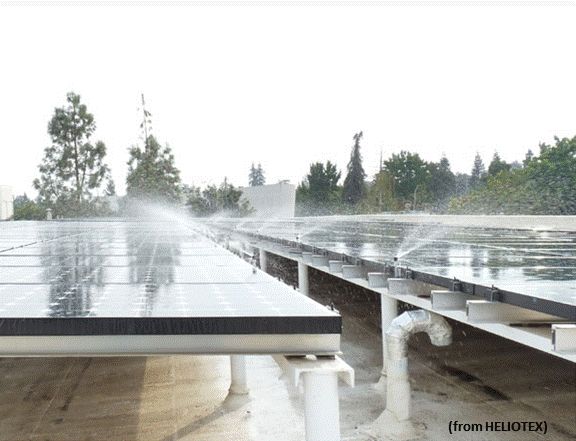How large a problem does panel or mirror soiling present to solar plant operators? Can robots be cost-effective in cleaning panels and heliostats in large-scale solar plants?
The soiling rate can be insignificant, but it can also be as significant as 1 percent per day, which could lead to an unacceptable 50 percent output degradation (with infrequent cleaning), according to Taft Instruments CTO Scott Potter.
“In deserts, summer soiling rates can get up to 9 percent per month, and that is worth cleaning. But winter rates might only be 1 percent per month. Where there is little rain, cleaning is cost-effective. Where there is a lot [of rain], cleaning doesn’t make sense.”
“First Solar has found that different geographies, seasons, and weather favor different solutions,” Potter said. “In places where labor is cheap, manual or semi-manual cleaning is cost-effective. In places where water is restricted, First Solar uses brush cleaning. And in places where water is available, [the company has] worked with Greenbotics," said Potter.
The state of the art is trucks or hosing systems spraying off surfaces or laborers doing the work manually, explained Potter. “At California’s Solar Energy Generating Stations, the oldest U.S. solar plants, they spray 32,000 gallons of water every night onto the parabolic mirrors. And the level of degraded reflectivity is unacceptable in newer CSP projects.”
Abengoa Solar’s Albatros manned trucks use a four-brush boom crane with two automatically controlled arms. A truck fleet comprising more than 35 vehicles is deployed at parabolic trough CSP plants in Spain. According to company information, the trucks clean at 1 kilometer per hour to 3 kilometers per hour and restore mirrors to 95.5 percent reflectivity.
Heliotex and KNE install sprinkler-like systems that spray off panel surfaces. Heliotex nozzles are fixed at panel edges and connected to electrical and water supplies. Wash-rinse cycles are done at programmed intervals with minimal maintenance. First Solar and SunPower are among its users, the company's website reports. KNE tubing installs on frames adjacent to panels. KNE promises similar programmable, low-maintenance service.

The growing list of startups with semi-automated robotic cleaning devices that can beat these solutions’ costs, high water use, and slow performance have a big opportunity in the emerging international CSP market, Potter said.
Sener’s Heliostat Cleaning Team Oriented Robot (HECTOR) is a major player in Spain with proven effectiveness at cleaning parabolic mirrors. Its battery-powered water-and-brush cleaning and efficiencies make it autonomous except for periodic water refills and battery changes by operators.
Based on similar technology, Greenbotics’ CleanFleet robots used a battery-powered brush-and-water system in Arizona last December to clean the 88,000 PV panels at SunEdison’s 25-megawatt Picture Rocks Solar Project in around seven days.
Other semi-robotic brush-and-water systems include Israel’s SolarRobot, eSolar’s Automatic Heliostat Cleaning Robot, Spain’s Novatec Fresnel robots, and OCS Energy’s SolarWash.
The NOMADD (No-Water Mechanical Automated Dusting Device) was designed at Saudi Arabia’s King Abdullah University of Science and Technology. It can do an automated daily dry sweep of panels or heliostats. Embedded sensors guide it and govern operations.

The problem with most such systems, Potter said, is that they require a two-worker crew to move them around. “In large installations, that is a logistical nightmare. As a result, surfaces are only cleaned one to four times a year.”
Taft Instruments’ Valin One device is one of a newer generation of cleaning technologies. Proven in the lab, it is now in field trials but is not yet in commercial service.
The preventative device (see video below) is 3 inches by 36 inches with extension tubes reaching to flat panel or heliostat edges. Affixed solar cells power oscillations over surfaces at 50 inches per minute, electrostatically dispersing dust “as long as the sun is shining,” Potter said. “There is minimal installation and no maintenance. You set it and forget it.”
Other advanced solutions include Boston University Professor Malay Mazumder’s self-cleaning solar panel technology developed for NASA’s solar-powered spacecraft. A transparent, electrically sensitive material is deposited on a transparent plastic panel cover. Embedded sensors detect dust and activate an electric, dust-repelling charge. The technology requires little electricity and removes about 90 percent of deposited dust, according to Mazumder.
The technology known as CleanFizz SA does essentially the same thing with “electrosonic waves” that repel 90 percent of accumulated dust within 30 seconds, according to the company website.
3M’s Anti-Soiling Liquid, a protective coating, rolls on panels and creates a translucent dust-resistant surface.
“The 3M product is a ‘co-opetition’ with Taft, because plant operators can apply the coating and use our solution,” Potter said. “It is the current standard but the coating has worn out and brush-cleaning can scrape it off. MIT is developing a nanoparticle coating.”
Soiling and infrequent cleanings prevent projects from meeting PPA output guarantees, but “preventive cleaning keeps performance consistent,” Potter said. “Demand for cost-effective, preventative cleaning is going to grow. In the past year, we have talked to every major developer with a big project coming up. Nobody has turned us away. The costs can be big, but the savings justify them.”



